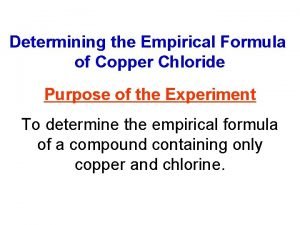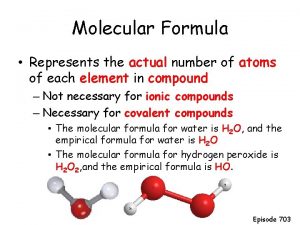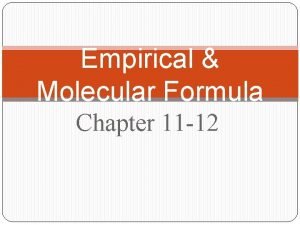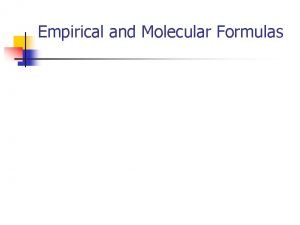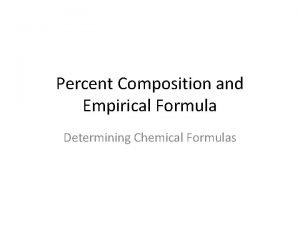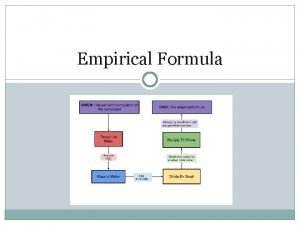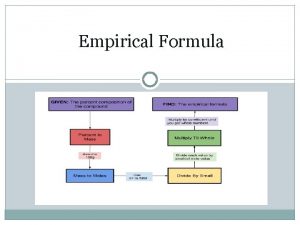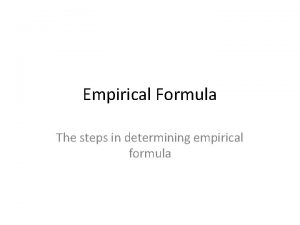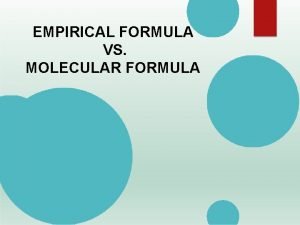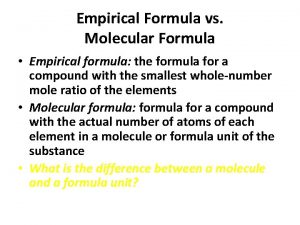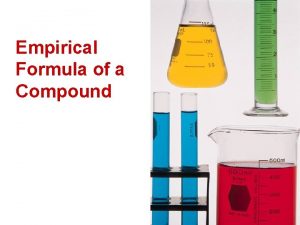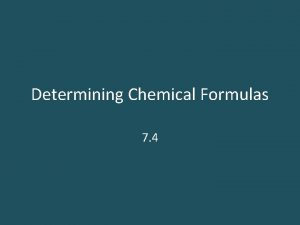Determining the Empirical Formula for a Compound The








- Slides: 8

Determining the Empirical Formula for a Compound • The empirical formula for a compound is the simplest _____ whole number _____ of the atoms in the compound. ratio Examples: H 2 O is the empirical formula for water. (can’t be reduced) C 1 H 2 O 1 Glucose, C H O , has the empirical formula ______. 6 12 6 Step 1: Change % to grams. Step 2: Convert grams to moles using the mole chart. Step 3: Divide each of these answers by the smallest number. Step 4: Your answers will be the subscripts for the empirical formula. Helpful Rhyme: % to mass, mass to mole, divide by small, times ’til whole.

Practice Problems: Calculate the empirical formula if a compound is found to be composed of 7. 8% Carbon and 92. 2% Cl 1. Assume 100 g since % , just change to % sign to g. 2. Find moles of each element 7. 8 g C 1 mole (% to mass) (mass to moles) = 0. 65 moles C = 2. 63 moles Cl 12. 0 g C 92. 2 g Cl 1 mole 35. 0 g Cl 2

3. Divide each mole found by lowest mole. (Round to whole #’s) (÷ by small) 0. 65 mole C = 1 0. 65 2. 63 mole Cl = 4 0. 65 4. Final answer, putting numbers in as subscripts. C 1 Cl 4 CCl 4 3

Practice Problems: Calculate the empirical formula if a compound is found to be composed of 42. 9% C and 57. 1% O 1. Assume 100 g since % , just change to % sign to g. 2. Find moles of each element 42. 9 g C 1 mole = (% to mass) (mass to moles) 3. 57 moles C 12. 0 g C 57. 1 g O 1 mole = 3. 57 moles O 16. 0 g O 4

3. Divide each mole found by lowest mole. (Round to whole #’s) (÷ by small) 3. 575 mole C = 1 3. 569 mole O =1 3. 569 4. Final answer, putting numbers in as subscripts. C 1 O 1 CO 5

Determining the Molecular Formula for a Compound • The molecular formula for a compound is either the same as the empirical formula ratio or it is a “_____ whole # _____ multiple of this ratio. It represents the true # of atoms in the molecule. Examples: 1) H 2 O is the empirical & molecular formula for water. 2) CH 2 O is the empirical formula for sugar, ethanoic acid, and methanol. The molecular formula for 6 glucose is C 6 H 12 O 6, (___times the empirical ratio!) Step 1: Determine the empirical formula for the compound. (See the previous steps in the notes. ) Step 2: Determine the “whole # multiple” by dividing the molecular formula mass (given in the problem) by the empirical formula molar mass. Multiply each of the empirical ratios by this whole number.

Practice Problems: 1) An unknown compound is composed of 5. 9% hydrogen and 94. 1% oxygen. The molecular formula mass is 34 g. Determine the molecular formula for the compound. (mass to moles) 5. 9 g H ÷ 1. 0 = 5. 9 moles H H = 5. 9% = 5. 9 g O = 94. 1% = 94. 1 g O ÷ 16. 0 = 5. 9 moles O H 5. 9 O 5. 9 (÷ by small) H 1 O 1 HO 5. 9 Molar mass of H 1 O 1 = 17 g (34 ÷ 17 = 2) [H 1 O 1 ]x 2 = Molecular formula mass divided by molar mass H 2 O 2

Practice Problems: 2) An unknown compound is composed of 40% carbon, 6. 6% hydrogen, and 53. 4% oxygen. Determine the molecular formula for the compound if the mass of one mole of the compound is 120 g. (mass to moles) 40 g C ÷ 12. 0 = 3. 3 moles C C = 40% = 40 g H = 6. 6% = 6. 6 g H ÷ 1. 0 = 6. 6 moles H O = 53. 4% = 53. 4 g O ÷ 16. 0 = 3. 3 moles O C 3. 3 H 6. 6 O 3. 3 (÷ by small) C 1 H 2 O 1 3. 3 Our formula mass = 30 g (Compare) (120 ÷ 30 = 4) CH 2 O [C 1 H 2 O 1 ]x 4 = C 4 H 8 O 4
 Copper chloride electron configuration
Copper chloride electron configuration Empirical formula of haemoglobin
Empirical formula of haemoglobin Percentage composition
Percentage composition Empirical formula vs molecular formula
Empirical formula vs molecular formula Which formula is an empirical formula?
Which formula is an empirical formula? Molecular formula and empirical formula
Molecular formula and empirical formula Which formula is an empirical formula?
Which formula is an empirical formula? Chapter 7 review chemical formulas and chemical compounds
Chapter 7 review chemical formulas and chemical compounds Empirical formula rhyme
Empirical formula rhyme
